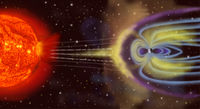
Photo from wikipedia
The P-band spaceborne synthetic aperture radar (SAR) is significantly affected by ionospheric scintillation. Although the traditional phase gradient autofocus (PGA) can estimate and compensate for the scintillation phase of the… Click to show full abstract
The P-band spaceborne synthetic aperture radar (SAR) is significantly affected by ionospheric scintillation. Although the traditional phase gradient autofocus (PGA) can estimate and compensate for the scintillation phase of the single-polarization SAR data, the quality of the refocused image will degrade at the scene edge. In this article, a modified PGA based on the weighted maximum likelihood (WML) estimator and data division is proposed for full-scene image refocusing. First, a data division strategy for scintillation corrupted image is introduced, which is based on the prior scintillation information including its power spectral density and autocorrelation function. Then, some preprocessing steps including data selection, circular shifting, and windowing are performed for suppressing the noise and clutter. Finally, the scintillation phase is estimated by the WML estimator with fewer iterations, and after the scintillation phase of all data blocks is obtained, the distorted full-scene image is refocused. Using the generated wideband ionospheric scintillation model phase screen, numerical simulations based on point targets and scenes derived from real spaceborne SAR data are carried out. The evaluation results about resolution, peak side-lobe ratio, integral side-lobe ratio, correlation coefficient, and image entropy demonstrate the effectiveness of the proposed algorithm.
Journal Title: IEEE Journal of Selected Topics in Applied Earth Observations and Remote Sensing
Year Published: 2022
Link to full text (if available)
Share on Social Media: Sign Up to like & get
recommendations!